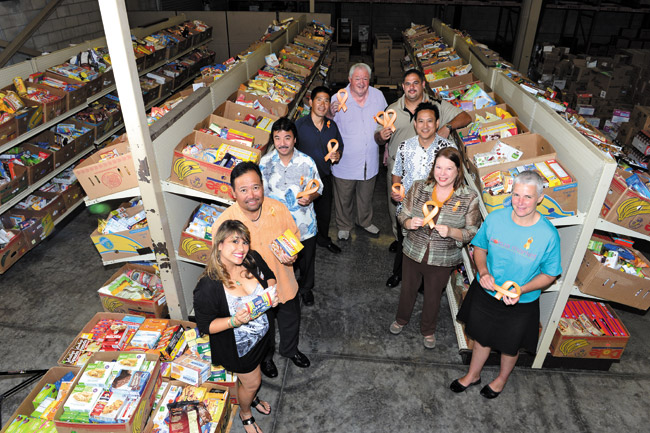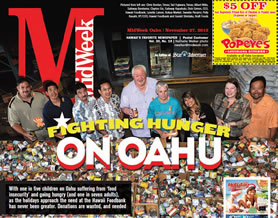Fighting Hunger on Oahu

From left: Sweetie Pacarro, Gerald Shintaku, Albert Nitta, Tad Fujiwara, Dick Grimm, Chris Borden, Clayton Eto, Polly Kauahi and Lynette Larson Photo by Nathalie Walker
With the holidays upon us and more people needing food assistance than ever, the Hawaii Foodbank needs donations
Picture five children you know. It can be any five: your cousins, grandchildren or the neighbor’s five boys whose ball is always getting hit into your yard.
Now realize that one of those five is going to bed hungry some nights, is waking up without breakfast and are just trying to hold on through their morning classes to get that one meal a day at lunch.
For grownups, it’s one in seven who are often hungry.
That is the world we live in and we are not speaking of war-ravaged Darfur or the storm-strafed Philippines – this is right here in Hawaii where 55,000 local kids live in food-insecure households, meaning they don’t have the means to provide themselves with the nutrition they need.
Helping bridge this chasm from how things are to how they should be is Hawaii Foodbank, which has been feeding the Island’s hungry for the past 30 years. It serves as a clearing house for food donations from private citizens and supermarkets, and then disseminates that food to nearly 300 feeding programs across Oahu. This adds up to nearly 12 million pounds of food distributed to 183,000 people in the past year alone.
Clearly, the economic upswing is not swinging for everyone.
“For many people, the economy hopefully is recovering, but for the people whom we serve, there is no such thing as an economic recovery right now,” says Polly Kauahi, vice president and COO of Hawaii Foodbank. “The numbers are still growing. We used to freak out when we would hear there were 100 people in line waiting for food. In 2009, we heard about 200 people in line and now we are getting reports of 300 people!”
These numbers not only tear at their hearts, but also change the very paradigm of how they do business. Previously the feeding agencies would come to the food bank with a van or a pickup to receive their allocation for their location, but with ballooning needs, that is no longer practical.
“Now the needs are so great they won’t fit in a pick-up truck anymore, they have to be delivered by Ohana Distributions,” says Kauahi, speaking of their oversized trucks. “Sometimes it takes two of the big trucks to feed that afternoon. More than half of our food is distributed this way now, but it at least gets the perishables out more quickly.”
This leads to not just distribution problems, but to depleted inventories in the Hawaii Foodbank warehouse. The supplies are now down to the lowest levels they have seen since the months following 9/11.
“We only have an eight-day supply; there are more empty shelves than full ones,” says Kauahi, who refuses to use the word emergency to describe the situation. “We only have 400,000 pounds of food and we distribute 50,000 pounds a day. As it is now, we will have to start rationing some of our food.”
For this reason, Hawaii Foodbank’s annual holiday fundraiser could not have come at a better time. You may have noticed the bright-green coupons sprouting up in your neighborhood grocery store – Times, Safeway, Don Quijote, Tamura’s and Kokua Market – asking for your help. You just need to pull off the chit that makes the most sense to you financially, hand it to the clerk and it will be added to the total at the bottom of your grocery bill.
The lead sponsor of this opportunity to help is Kraft Foods which, according to Kauahi, took a dying fundraiser and turned it into a winner.
“When I came, Check-Out Hunger had been very successful, but then it bombed because it wasn’t new or exciting anymore,” says Kauahi. “We did not have the resources to make it so, and we were thinking about scrapping the program. That is when we went to Gerald Shintaku at Kraft and asked if it would be the sponsor for the program, and it has grown every year since.”
Gone were the handwritten signs asking for direct donations of dollars. Instead, they positioned the request so that you knew what you were sponsoring: $2.81 to feed a child breakfast for a week, $12.43 to feed a senior lunch for a week or $16.84 to feed a family dinner for a week.
“It makes the requests have meaning, the bag of potato chips they are buying can feed a child, can feed two children,” says Kauahi. “I know people who will give up that bag of chips to feed a child for a week. It makes it an absolutely easy way to give.”
This partnership with Kraft just made sense, according to Shintaku, who cites Kraft as a corporation with a commitment to ending hunger in this country.
“I just thought it was a natural fit because Kraft is all about food and we support the effort as a national organization, but we didn’t have anyone represented here in Hawaii,” says Shintaku, who now serves on the Hawaii Foodbank board. “We help spread the word, we do the creative stuff that goes into the stores, rally the retailers, do some media – and the rest is up to the people of Hawaii, and they give so much.”
Another way Hawaii Foodbank is helping the hungry youths of Hawaii is through its backpack program.
At a certain elementary school here on Oahu, which shall remain nameless to protect its privacy, there are 404 students – 365 of whom are on free or reduced lunch.
In order to help these kids get through the weekend, the food bank packs them up four to six small meals in a backpack that the kids can bring home with them. They return the backpack Monday to be refilled for the following weekend.
This not only gives them the nutrition they need, but also provides a valuable teaching moment for the kids.
“I watched the principal get down on one knee and talk to the kids, saying, ‘The food bank is giving this to you because you need it right now, but when you are an adult and you have a job, what you are going to do is give back to your community because your community gave to you,'” says Kauahi.
It is moments like these that give the Sisyphean task of feeding the hungry meaning. When Kauahi first joined Hawaii Foodbank, its former president Jim Baldwin told her that their business was to put themselves out of business. They had a five-year plan to end hunger in the Islands. Yet every time they appear to be making progress, something comes along to erase all their success, whether it was welfare reform in 1996, the tragedies of Sept. 11 or the cutbacks on food stamps in 2013.
“If it was always the same people for the same reasons who we were feeding and you didn’t see the individual success stories, I definitely think that could be depressing,” says Kauahi.
“But it’s not. There is always a reason for what is happening in the community. Are there people there who are not trying to help themselves? Absolutely, but there are a lot more people whose needs are real.”
So Hawaii Foodbank trudges onward, using a skeleton crew of eight volunteers in its warehouse to sort produce and organize the canned goods that feed so many of us here in Hawaii. But rather than let the enormity of their mission overwhelm them, Kauahi has the crew focus on the impact they have on each individual they feed.
“That is the way that progress is made, in very small steps,” says Kauahi. “It’s a great thing to know you are feeding 183,000 people, but it is that one person who you see who is delighted at what they are receiving that makes what we are doing so important.”






